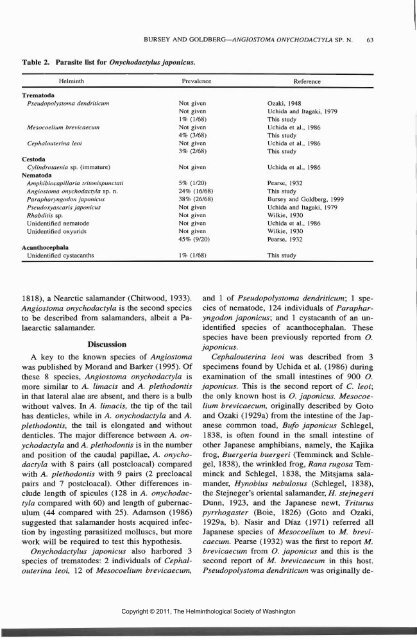Comparative Parasitology 67(1) 2000 - Peru State College
Comparative Parasitology 67(1) 2000 - Peru State College
Comparative Parasitology 67(1) 2000 - Peru State College
Create successful ePaper yourself
Turn your PDF publications into a flip-book with our unique Google optimized e-Paper software.
Table 2. Parasite list for Onychodactylus japonicus.<br />
BURSEY AND GOLDBERG—ANGIOSTOMA ONYCHODACTYLA SP. N. 63<br />
Helminth Prevalence Reference<br />
Trematoda<br />
Pseiidopolystoma dendriticum<br />
Mesocoeliurn brevicaecum<br />
Cephalouterina leoi<br />
Cestoda<br />
Cylinclrotaenia sp. (immature)<br />
Nematoda<br />
Amphibiocapillaria tritonispunctati<br />
Angiostoma onychodactyla sp. n.<br />
Parapharyngodon japonicus<br />
Pseudoxyascaris japonicus<br />
Rhabditis sp.<br />
Unidentified nematode<br />
Unidentified oxyurids<br />
Acanthocephala<br />
Unidentified cystacanths<br />
Not given<br />
Not given<br />
1% (1/68)<br />
Not given<br />
4% (3/68)<br />
Not given<br />
3% (2/68)<br />
Not given<br />
5% (1/20)<br />
24% (16/68)<br />
38% (26/68)<br />
Not given<br />
Not given<br />
Not given<br />
Not given<br />
45% (9/20)<br />
1% (1/68)<br />
1818), a Nearctic salamander (Chitwood, 1933).<br />
Angiostoma onychodactyla is the second species<br />
to be described from salamanders, albeit a Palaearctic<br />
salamander.<br />
Discussion<br />
A key to the known species of Angiostoma<br />
was published by Morand and Barker (1995). Of<br />
these 8 species, Angiostoma onychodactyla is<br />
more similar to A. limacis and A. plethodontis<br />
in that lateral alae are absent, and there is a bulb<br />
without valves. In A. limacis, the tip of the tail<br />
has denticles, while in A. onychodactyla and A.<br />
plethodontis, the tail is elongated and without<br />
denticles. The major difference between A. onychodactyla<br />
and A. plethodontis is in the number<br />
and position of the caudal papillae, A. onychodactyla<br />
with 8 pairs (all postcloacal) compared<br />
with A. plethodontis with 9 pairs (2 precloacal<br />
pairs and 7 postcloacal). Other differences include<br />
length of spicules (128 in A. onychodactyla<br />
compared with 60) and length of gubernaculum<br />
(44 compared with 25). Adamson (1986)<br />
suggested that salamander hosts acquired infection<br />
by ingesting parasitized molluscs, but more<br />
work will be required to test this hypothesis.<br />
Onychodactylus japonicus also harbored 3<br />
species of trematodes: 2 individuals of Cephalouterina<br />
leoi, 12 of Mesocoeliwn brevicaecum,<br />
Ozaki, 1948<br />
Uchida and Itagaki,<br />
This study<br />
Uchida et al., 1986<br />
This study<br />
Uchida et al., 1986<br />
This study<br />
Uchida et al., 1986<br />
1979<br />
Pearse, 1932<br />
This study<br />
Bursey and Goldberg, 1999<br />
Uchida and Itagaki, 1979<br />
Wilkie, 1930<br />
Uchida et al., 1986<br />
Wilkie, 1930<br />
Pearse, 1932<br />
This study<br />
and 1 of Pseiidopolystoma dendriticum.', 1 species<br />
of nematode, 124 individuals of Parapharyngodon<br />
japonicus; and 1 cystacanth of an unidentified<br />
species of acanthocephalan. These<br />
species have been previously reported from O.<br />
japonicus.<br />
Cephalouterina leoi was described from 3<br />
specimens found by Uchida et al. (1986) during<br />
examination of the small intestines of 900 O.<br />
japonicus. This is the second report of C. leoi;<br />
the only known host is O. japonicus. Mesocoeliurn<br />
brevicaecum, originally described by Goto<br />
and Ozaki (1929a) from the intestine of the Japanese<br />
common toad, Bufo japonicus Schlegel,<br />
1838, is often found in the small intestine of<br />
other Japanese amphibians, namely, the Kajika<br />
frog, Buergeria buergeri (Temminck and Schlegel,<br />
1838), the wrinkled frog, Rana rugosa Temminck<br />
and Schlegel, 1838, the Mitsjama salamander,<br />
Hynobius nebulosus (Schlegel, 1838),<br />
the Stejneger's oriental salamander, H. stejnegeri<br />
Dunn, 1923, and the Japanese newt, Triturus<br />
pyrrhogaster (Boie, 1826) (Goto and Ozaki,<br />
1929a, b). Nasir and Diaz (1971) referred all<br />
Japanese species of Mesocoelium to M. brevicaecum.<br />
Pearse (1932) was the first to report M.<br />
brevicaecum from O. japonicus and this is the<br />
second report of M. brevicaecum in this host.<br />
Pseudopolystoma dendriticum was originally de-<br />
Copyright © 2011, The Helminthological Society of Washington
















